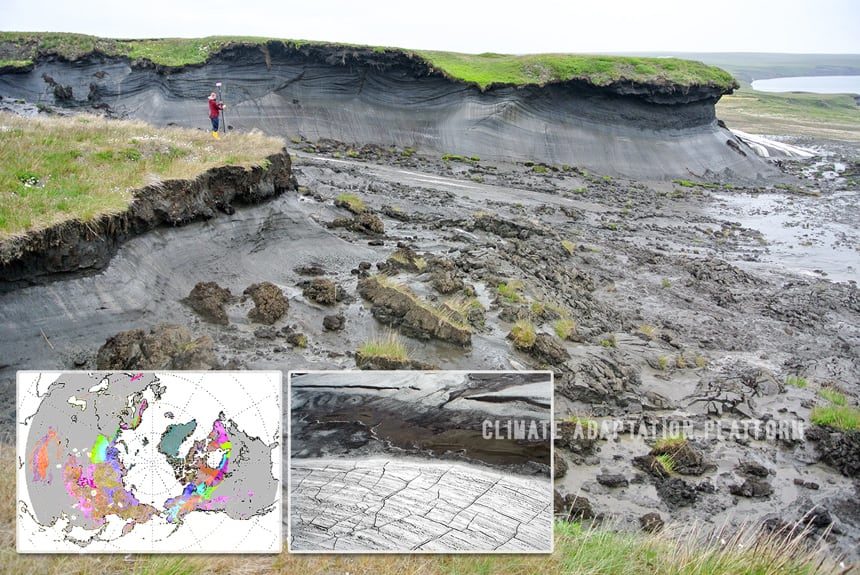Permafrost is a permanently frozen land, or so we thought until climate change happens. Temperatures in the Arctic has risen to two or three times faster than the rest of the plane in the last 50 year to two to three degrees Celsius above pre-industrial levels.
As permafrost thaws away due to the warming climate, it poses threats to the environment, infrastructure, and human lives.
Covering a quarter of the northern hemisphere landmass, mainly above the Arctic Circle, permafrost is believed to contain around 1.7 trillion tonnes of carbon in a state of organic matter.
It accounts for twice the amount of carbon dioxide already in the atmosphere. Permafrost thaw could send these vast amounts of methane and carbon dioxide into the atmosphere, causing further warming and creating a feedback loop of melting and more GHG emissions.
Among the countries inside the Arctic Circle, Russia is the most vulnerable. Nearly 70% of the roads, cities, industries and pipelines are in Russia. This area also holds 90% of its population. It is where heavy apartment buildings and extensive industrial facilities are built.
The study on permafrost by Jan Hjort, a scientist at the Finland’s University of Oulu, shows that around 120,000 buildings, 40,000 kilometres (25,000 miles) of roads and 9,500 kilometres of pipelines are at risk from permafrost thaw; half of them will be at high risk by 2060.
According to the study, “The strength of soil drops substantially as temperatures rise above the melting point and ground ice melts.” When soil is soaked, its load-bearing capacity is reduced, and when structures subside, it causes cracks and damages in surfaces, structures, and even in gas pipelines, the study mentions.
The more expansive permafrost areas are also found in Siberia and the Arctic in Alaska. Still, the riskiest places because they host numerous gas and oil pipelines are in the largest cities in Nenets, in the Yamal Peninsula in Russia.
In Vorkuta city, 80% of its buildings are already showing deformations due to the shifting of permafrost.
In 2020, a ruptured fuel tank spilled 21,000 tonnes of diesel into nearby waters due to the sudden collapse of its support. This event is blamed on weakening the plant’s foundation due to permafrost thawing.
Infrastructure resilience against permafrost thawing impacts
Given the severe risks posed by the permafrost’s thawing, the apparent answer to mitigating the risk is to curb emissions rapidly. Are there ways to prevent it from damage or falling when it comes to infrastructure?
Dr Hjort and his colleagues suggest ways to increase infrastructure resilience, some of which are already being used in various Arctic locations.
- First, remove excess heat from the thawing soil near the structures by adding porous limestone lawyers to read beds that can generate convection, allowing hot air to dissipate. Reducing the angle of embankments can increase wind flow, and reducing snow accumulation can also prevent heat from getting trapped.
- Second, limiting ground absorption of heat through insulating road embankments by increasing their thickness. Raising paved surfaces reflectivity also limits heat absorption.
- Third, reinforcing the ground for stronger foundations by replacing permafrost layers with more stable materials. One way to do this is to thaw the permafrost in a controlled matter and build on that consolidated layer.
The Economist article “A lot of Arctic infrastructure is threatened by rising temperatures” notes that none of these innovative solutions will help if there is a haphazard approach to maintenance.
The article further explains that previous studies from 1980 to 2000 shows that poor maintenance caused the most damage to structures in Russia.
Climate change is bound to make matters worse. Local governments and authorities need to get things right to save vast amounts of infrastructure, industries and lives in the Arctic region.
Sources:
Permafrost inspired me to ponder the interaction between Arctic nature and humans. (2019, May 28). University of Oulu. Retrieved from https://www.oulu.fi/university/permafrost%20inspired%20me%20to%20ponder%20the%20interaction%20between%20arctic%20nature%20and%20humans
Climate change: thawing permafrost a triple threat. (2022, January 12). PhysOrg. Retrieved from https://www.scientificamerican.com/article/how-much-worse-will-thawing-arctic-permafrost-make-climate-change/
A lot of Arctic infrastructure is threatened by rising temperatures. (2022 January 15). The Economist. Retrieved from https://www.economist.com/science-and-technology/a-lot-of-arctic-infrastructure-is-threatened-by-rising-temperatures/21807133



Leave a Reply